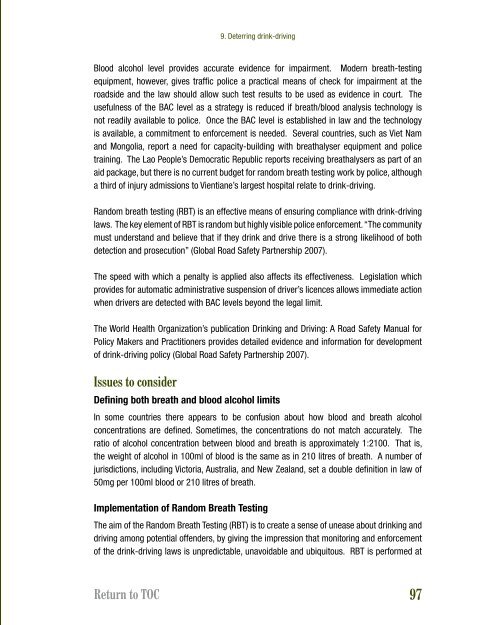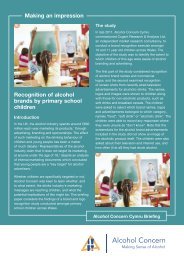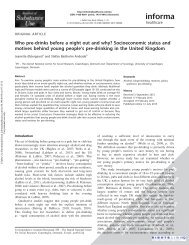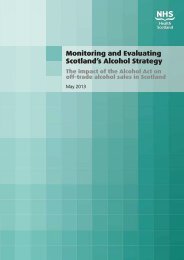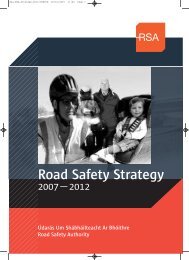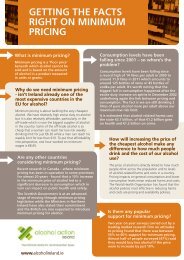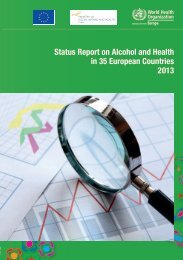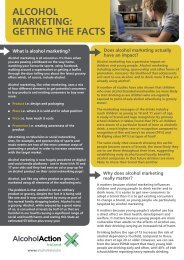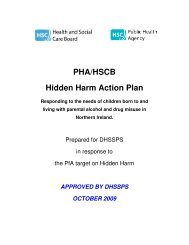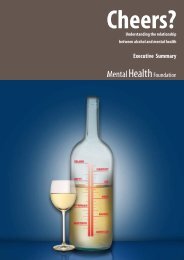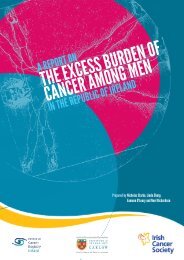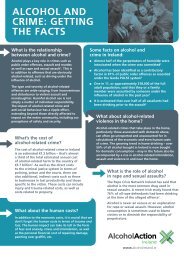Addressing the harmful use of alcohol - WHO Western Pacific Region
Addressing the harmful use of alcohol - WHO Western Pacific Region
Addressing the harmful use of alcohol - WHO Western Pacific Region
Create successful ePaper yourself
Turn your PDF publications into a flip-book with our unique Google optimized e-Paper software.
9. Deterring drink-driving<br />
Blood <strong>alcohol</strong> level provides accurate evidence for impairment. Modern breath-testing<br />
equipment, however, gives traffic police a practical means <strong>of</strong> check for impairment at <strong>the</strong><br />
roadside and <strong>the</strong> law should allow such test results to be <strong>use</strong>d as evidence in court. The<br />
<strong>use</strong>fulness <strong>of</strong> <strong>the</strong> BAC level as a strategy is reduced if breath/blood analysis technology is<br />
not readily available to police. Once <strong>the</strong> BAC level is established in law and <strong>the</strong> technology<br />
is available, a commitment to enforcement is needed. Several countries, such as Viet Nam<br />
and Mongolia, report a need for capacity-building with breathalyser equipment and police<br />
training. The Lao People’s Democratic Republic reports receiving breathalysers as part <strong>of</strong> an<br />
aid package, but <strong>the</strong>re is no current budget for random breath testing work by police, although<br />
a third <strong>of</strong> injury admissions to Vientiane’s largest hospital relate to drink-driving.<br />
Random breath testing (RBT) is an effective means <strong>of</strong> ensuring compliance with drink-driving<br />
laws. The key element <strong>of</strong> RBT is random but highly visible police enforcement. “The community<br />
must understand and believe that if <strong>the</strong>y drink and drive <strong>the</strong>re is a strong likelihood <strong>of</strong> both<br />
detection and prosecution” (Global Road Safety Partnership 2007).<br />
The speed with which a penalty is applied also affects its effectiveness. Legislation which<br />
provides for automatic administrative suspension <strong>of</strong> driver’s licences allows immediate action<br />
when drivers are detected with BAC levels beyond <strong>the</strong> legal limit.<br />
The World Health Organization’s publication Drinking and Driving: A Road Safety Manual for<br />
Policy Makers and Practitioners provides detailed evidence and information for development<br />
<strong>of</strong> drink-driving policy (Global Road Safety Partnership 2007).<br />
Issues to consider<br />
Defining both breath and blood <strong>alcohol</strong> limits<br />
In some countries <strong>the</strong>re appears to be confusion about how blood and breath <strong>alcohol</strong><br />
concentrations are defined. Sometimes, <strong>the</strong> concentrations do not match accurately. The<br />
ratio <strong>of</strong> <strong>alcohol</strong> concentration between blood and breath is approximately 1:2100. That is,<br />
<strong>the</strong> weight <strong>of</strong> <strong>alcohol</strong> in 100ml <strong>of</strong> blood is <strong>the</strong> same as in 210 litres <strong>of</strong> breath. A number <strong>of</strong><br />
jurisdictions, including Victoria, Australia, and New Zealand, set a double definition in law <strong>of</strong><br />
50mg per 100ml blood or 210 litres <strong>of</strong> breath.<br />
Implementation <strong>of</strong> Random Breath Testing<br />
The aim <strong>of</strong> <strong>the</strong> Random Breath Testing (RBT) is to create a sense <strong>of</strong> unease about drinking and<br />
driving among potential <strong>of</strong>fenders, by giving <strong>the</strong> impression that monitoring and enforcement<br />
<strong>of</strong> <strong>the</strong> drink-driving laws is unpredictable, unavoidable and ubiquitous. RBT is performed at<br />
Return to TOC<br />
97


